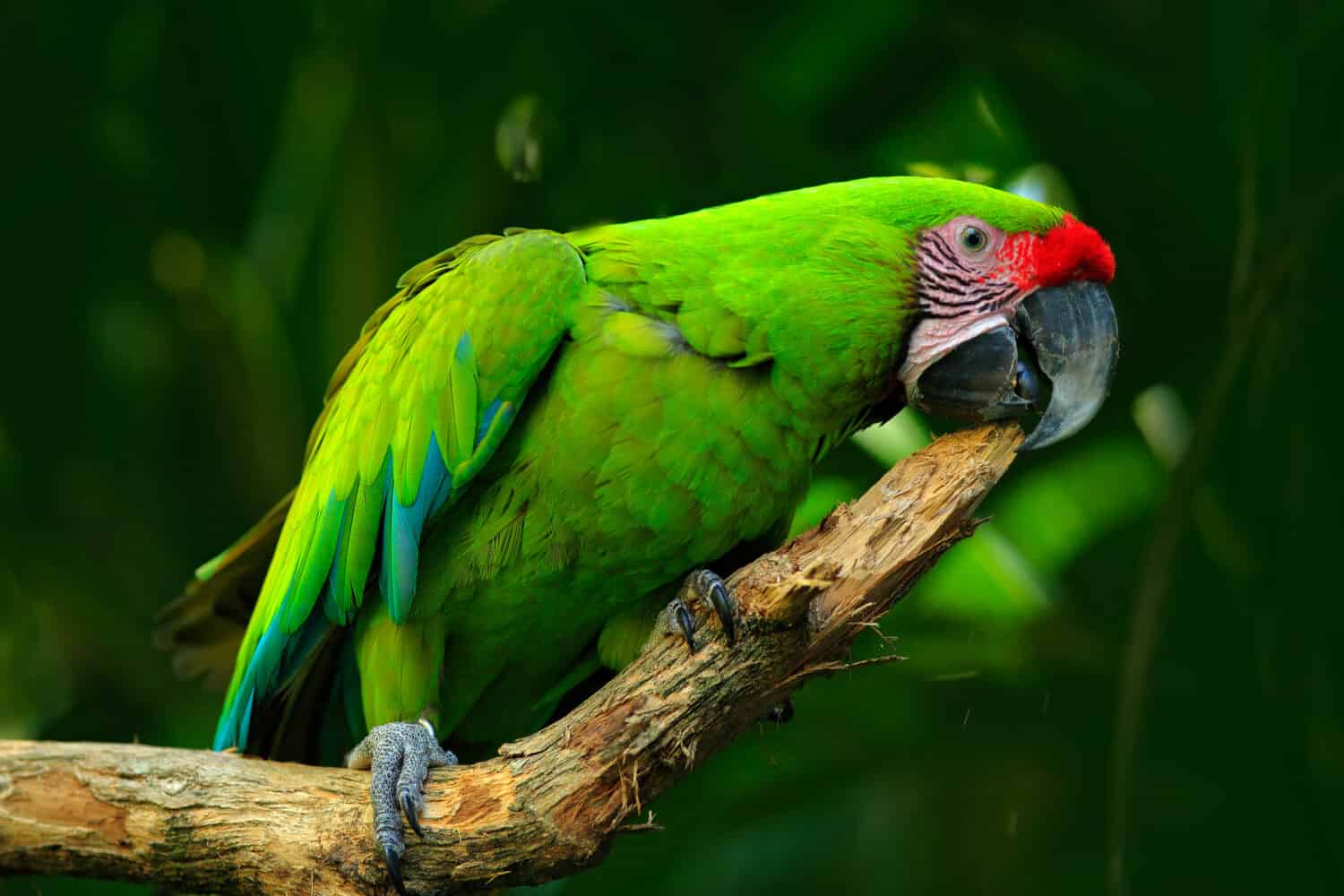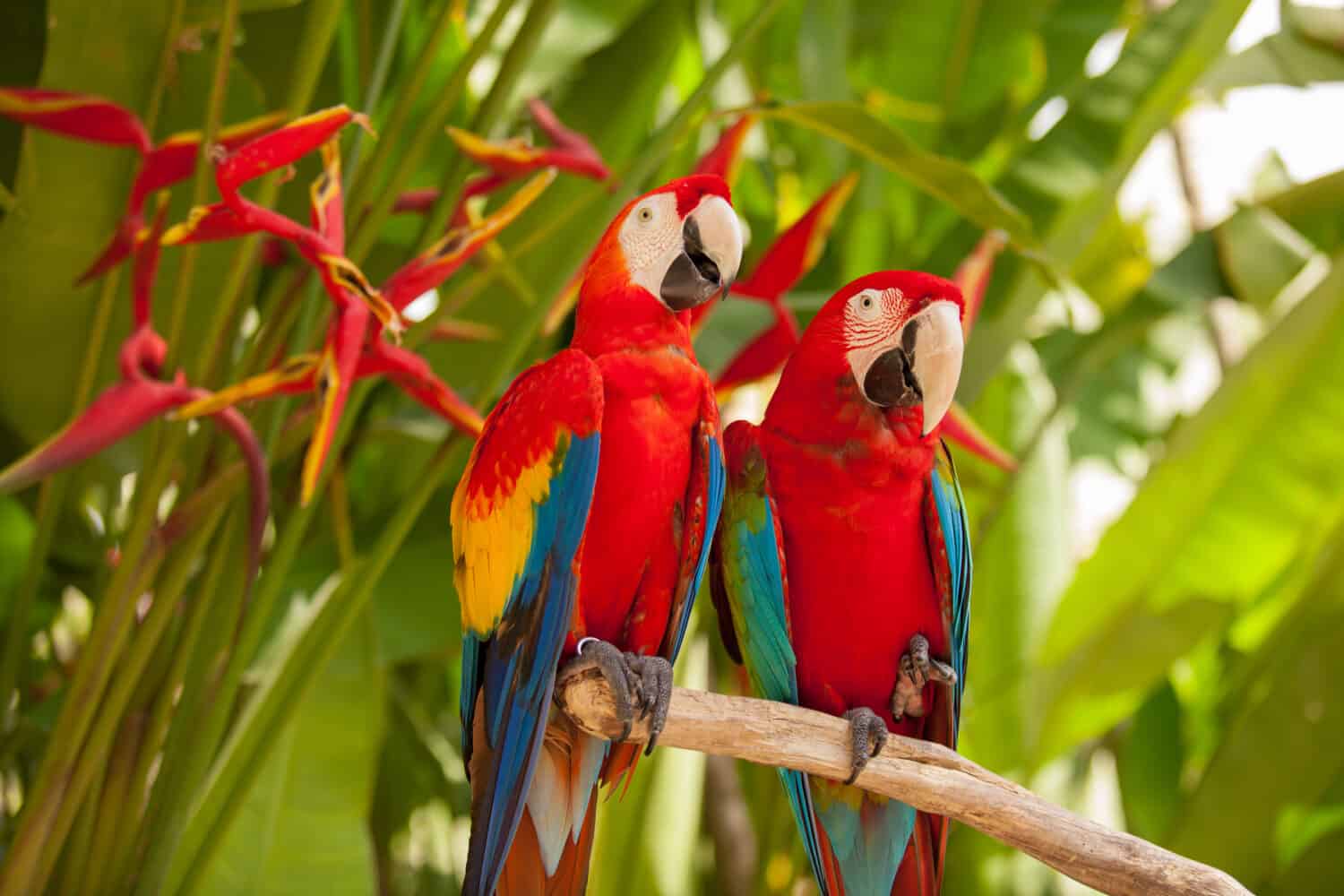“Macaw” is the common name given to a group of large Neotropical parrots spread across a half dozen different genera (Anodorhynchus, Ara, Cyanopsitta, Diopsittaca, Primolius, and Orthopsittaca). There are currently 17 living species recognized, along with two confirmed extinct and at least five hypothetical extinct species. As with parrots in general, macaws as a group exhibit an impressive diversity of colors in their plumage. One species, the scarlet macaw (Ara macao), basically looks like a flying rainbow! Read on to find out how macaws can make so many different feather colors and how they rank in rarity.
#1 Green

The great green macaw (
Ara ambiguus) is one of several macaw species that displays a mostly green plumage.
©Ondrej Prosicky/Shutterstock.com
As with all parrots, this is the most commonly seen plumage color in macaws. In addition to several primarily green species, the color appears on just about every other macaw, except for blue macaws (see #2 below).
As noted above, green is by far the most common color seen in parrots across the world. However, parrots don’t actually make green pigment — in fact, only a handful of bird species can. Rather, parrots can make their feathers green in one of two ways. One is to give their feathers a subtle olive tinge through a combination of yellow and black/brown pigments. The other is to combine yellow pigment and blue structural color (see #2 and #3 below) to produce shades of bright “parrot green.”
#2 Blue

Spix’s macaw (
Cyanopsitta spixii) is one of four species collectively known as the “blue macaws.”
©Danny Ye/Shutterstock.com
Blue is another common color in the parrot world, although it is more often seen as a part of a multicolored plumage rather than the main body color. There are relatively few primarily blue parrots, but the majority of them are macaws! There are four blue macaw species in the Anodorhynchus and Cyanopsitta genera. In addition, two macaw species are mainly turquoise blue and yellow, the blue-and-yellow macaw (Ara ararauna) and blue-throated macaw (Ara glaucogularis). Furthermore, all other macaw species possess at least some blue plumage.
These beautiful blues are not biological pigments, but rather structural color that is purely a trick of optics. Similar to how the sky and ocean can also look blue to us, these birds’ feathers refract light in just the right way to appear blue to our eyes. In fact, blue feather pigments simply don’t exist in the bird world, so every “blue” bird you see uses this same trick of structural color to fool your eyes!
#3 Red, Orange, Yellow

Both the scarlet macaw (
Ara macao) (left) and red-and-green macaw
(Ara chloropterus) (right) have red bodies; the first also has a large yellow wing patch, with a tiny bit of orange too.
©Katia Titova/Shutterstock.com
For many birds, their red, orange, and yellow colors are the result of pigments called carotenoids, which they obtain through their food. Parrots, however, get these colors differently. They have their own unique pigments, called psittacofulvins, which cover the same color spectrum that carotenoids do. Unlike carotenoids though, these pigments are made by the parrots’ bodies rather than obtained through diet. These colors are therefore commonly found in the plumage of many parrots, including macaws.
When it comes to macaws, red is the most commonly seen color of the psittacofulvin spectrum. Two species have red as a primary body color, the scarlet macaw and red-and-green macaw. In addition, several other species have areas of red plumage. Yellow also turns up often in macaws, though it’s not quite as common as red. Two species have yellow across the fronts of their bodies, the blue-and-yellow macaw (Ara ararauna) and blue-throated macaw (Ara glaucogularis). Several other species also have at least some yellow plumage.
Orange is the least common of the psittacofulvin color trio among the macaws. It is most often seen in the transition between red and yellow feathers. In Caribbean populations of blue-and-yellow macaws, the yellow underside also often takes on a more butterscotch hue. Additionally, orange feathers turn up on some of the many aviculture hybrids, such as the harlequin macaw (blue-and-yellow macaw x red-and-green-macaw).
#4 Black, Gray, Brown

This chestnut-fronted macaw (
Ara severa) shows off the narrow dark chestnut frontal band that gives the species its common name.
©Tracy Starr/Shutterstock.com
These colors come from biological pigments known as melanins. Melanins are common pigments throughout the bird world — and indeed, in all vertebrates, including us humans! These are the same pigments that give us our range of hair and skin color. Eumelanin is the darker “black” version of melanin, which can also produce gray when diluted. Meanwhile, phaeomelanin is the lighter “brown” version, although it can also produce ruddy reds and sandy yellows (again, think human hair color). While there are no macaws with any of these colors as their primary body color, several species have one or more of these colors as part of their plumage, most often around the head.
#5 Purple

The deep blue feathers of hyacinth macaws (
Anodorhynchus hyacinthinus) can sometimes appear indigo or even violet.
©Uwe-Bergwitz/iStock via Getty Images
Purple is created by the combination of red pigment and blue structural color. These feather colors are rare in the parrot world in general, and all but nonexistent in macaws. The one exception is the subtle violet tinge sometimes seen in the feathers of blue macaws. Of course, it is always possible a genetically mutated individual or domestically bred morph could end up with purple feathers. However, they are not part of the regularly occurring plumage of any other known wild macaw species.
#6 White and Pink (tie)

This blushing military macaw (
Ara militaris) is one of the best examples of pink color in macaws, though it’s just bare skin, not feathers.
©J. Esteban Berrio/Shutterstock.com
If a feather is lacking in both pigment and structural color, it will just appear white. While white highlights are not uncommon in the parrot world, no macaw species display white plumage (except when caused by a genetic mutation such as leucism or albinism). The white you see on the faces of many macaw species is actually bare skin!
Similarly, pink is usually just a diluted red pigment on an otherwise white feather. While it may be possible for pink feathers to occur as the result of a genetic mutation or through breeding morphs in aviculture, pink is not a regularly occurring feather color in any wild macaw species.
One place pink does sometimes make an appearance on macaws, however, is in bare parts. A few species have a pinkish tinge to their legs, and a few also possess small areas of pink facial skin. In some species, the bare white area around their face can also blush pink!
Summary of Macaw Colors: Most Common to Rarest
| Color | Made By | Rarity |
|---|---|---|
green | mixing of yellow pigment and melanins (olive tinge); mixing of yellow pigment and blue structural color (bright green) | most common plumage color in macaws; several primarily green species |
| blue | structural color | primary color of the four blue macaw species; secondary color in two additional species; additional color in all other species |
| red, orange, yellow | psittacofulvins (unique parrot pigments) | common colors found in most macaw species other than the blue macaws |
| black, gray, brown | melanin pigments | not found as primary body color in any macaw; only seen in small areas of plumage, most often on the head |
| purple | mixing of red pigment and blue structural color | rare plumage color in macaws; only seen as a subtle violet tinge in some blue macaw feathers |
| white and pink | lack of any pigment or structural color; diluted red pigment | not part of the normal plumage color of any macaw species; can be found on bare parts |
The photo featured at the top of this post is © Super Prin/Shutterstock.com
Thank you for reading! Have some feedback for us? Contact the AZ Animals editorial team.







